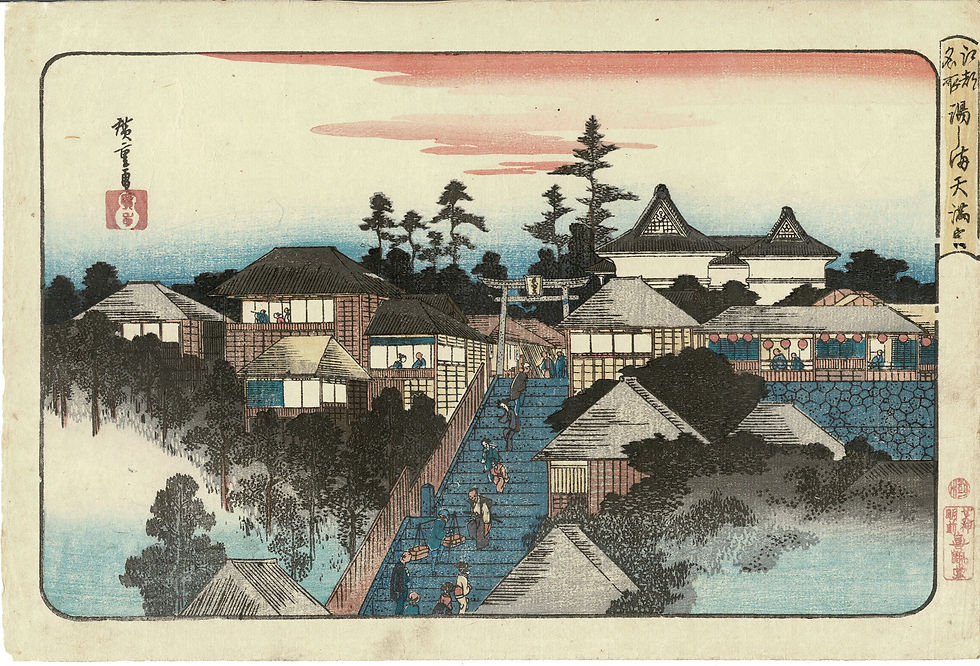Artist: Yoshida Hiroshi
Title: Taj Mahal at Night, No. 6
Series: Taj Mahal
Signed: signed in ink in the image, Yoshida, with artist's seal Hiroshi, with self printed jizuri seal at upper left. Printed on bottom, Night in Taj Mahal no. 6, and signed in pencil Hiroshi Yoshida
Date: 1932
Format: Double oban
15 3/4'' x 21 1/2''
Fine color, impression, and condition
Hiroshi Yoshida - Night in Taj Mahal no. 6
Hiroshi Yoshida was a 20th-century Japanese painter and woodblock printmaker. He is considered one of the leading figures in the revival of Japanese printmaking after the Meiji period in 1912. *Hiroshi Yoshida, 1949. Credit: Wikipedia.com
Hiroshi Yoshida was born on 19th September 1876 in the Fukuoka Prefecture in Kyushu, southern Japan. He was born Hiroshi Ueda, the second son of Ueda Tsukane, a schoolteacher from an old samurai family. But in 1891, he was adopted by his art teacher, Yoshida Kasaburo, and took his surname.
In 1893 he went to Kyoto to study painting, and the following year to Tokyo to join a private school; he also joined the Meiji Fine Arts Society. These institutions were teaching and encouraging Western-style painting following the opening up of Japan in 1868 after 200 years of seclusion.
Yoshida was famous for his globetrotting portfolio of designs of famous landmarks executed in the traditional Japanese styling mixed with the training he received in the west. The Taj Mahal, Yosemite National park, and the Grand Canyon are some notable areas he incorporated in his prints.
From 1899 to 1901, Hiroshi Yoshida made the first of many visits to the USA and Europe, where he successfully exhibited, made artistic connections, and sold his watercolors. He realized a good market in the West for his work and went to the USA, Europe, and North Africa in 1903-7 with his stepsister and fellow artist Fujio (the daughter of his adopted father), whom he married on their return.
From then until 1920, he concentrated on oils and watercolors in the light and airy style he had learned in the West.
In 1920 Yoshida began to design woodblock prints for the publisher Watanabe Shozaburo (1885-1962), who was looking for a Western-style artist to create prints.
Tragically on September 1, 1923, the great Kanto earthquake brought disaster upon the Yokohama-Tokyo metropolitan area, which was almost entirely burned to the ground. With an entire cityscape made almost entirely out of wood, fires were a frequent issue, as it was not the first time uncontained fires had destroyed Tokyo.
Yoshida’s house was burned down, along with the original woodblocks and designs he kept. The same fires destroyed Kawase Hasui’s original sketches and paintings and Watanabe Shozuburo's print studio. The original woodblocks of almost every shin hanga artist using Watanabe’s studio in and around 1923 went up in smoke, lost to the world.
In the subsequent years following the disaster, Watanabe would loosen his strict policy, which limited the number of prints issued to no more than 100-200 first editions. Second and third editions numbered no more than 4-500; Watanabe was now publishing 300 in the first and even larger amounts of second and third editions. Many of his best-selling designs were recarved, with some designs rumored to have been printed as much as ten to twenty thousand times, although no one can know for sure.
Yoshida left for the USA once more to raise funds for himself and others; he toured through the western USA and realized that excellent prints were eagerly sought after in North America. On his return, he established his studio and began to produce his own designs in print form. From 1925 onwards, Yoshida devoted his career to prints, supervising all aspects of their production and holding very high standards.
The traditional process of creating Japanese woodblock prints necessitated three strictly separated skills: the artist who designed the print subject, the carver, and finally, the printer and publisher. In contrast to this traditional approach, the sosaku hanga artist’s believed that the process of creating a print - design, caring, printing - should be performed by the artist himself.
In the Watanabe Print Shop, painters, carvers, and printers had equal input, with the publisher as the ultimate director. Hiroshi Yoshida believed that the painter, as the initial creator of the design, should have supreme authority and that he, as the painter, should supervise the carvers and printers and, in so doing, direct every step of the production. One of the reasons why he split away from his previous association with the Watanabe Print Shop: was to have complete control of his prints from painting to print. He said he needed more skills than the artisans he supervised to use their talents fully, so he constantly strove to expand his knowledge of woodblock carving and printing techniques.






























